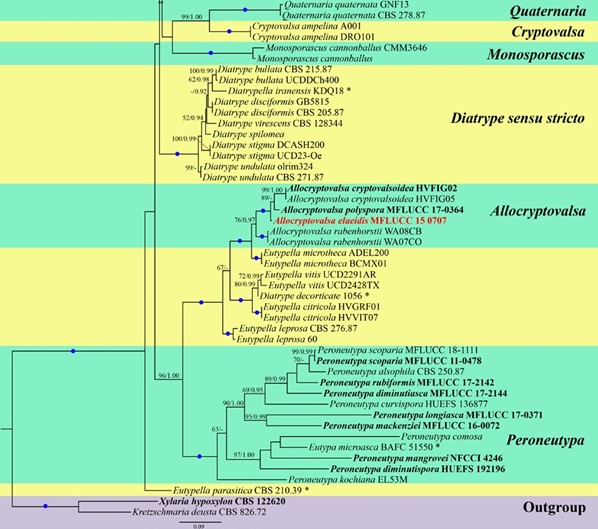Allodiatrype Konta & K.D. Hyde, in Konta, Maharachchikumbura, Senanayake, McKenzie, Stadler, Boonmee, Phookamsak, Jayawardena, Senwanna, Hyde, Elgorban & Eungwanichayapant, Mycosphere 11(1): 247 (2020)
Index Fungorum number: IF 556641; Facesoffungi number: FoF 06299
Etymology – In reference to the morphological resemblance to Diatrype
Saprobic on dead petiole of palm (Arecaceae), and on a dead stem of unidentified plants. Sexual morph: Stromata scattered or aggregated on the host, erumpent, arising through cracks in the bark, irregularly shaped or circular, orbicular, convex surface, 1–10-ascomata immersed in one stroma, with or without a black stromatic zone. Ostiole opening through host bark and appearing as black spots, surrounded with a ring-like, ostiolar opening, composed of an outer layer of dark brown, small, tightly packed, thin parenchymatous cells and an inner layer of yellowish, large, loosely packed, parenchymatous cells. Ascomata perithecial, immersed in stromatic tissue, aggregated, brown, globose to sub-globose, narrowing towards the apex and very narrow at the base of ostiolar canal, thin-walled, ostiolate; ostiolar canal, with periphyses, ostiolar opening covered with carbonaceous, black cells; periphyses hyaline, filamentous. Peridium comprising an outer layer of yellow-brown, thick-walled cells of textura angularis and a thin, inner stratum of yellow, thick-walled cells of textura angularis. Hamathecium composed of septate, hyaline paraphyses. Asci unitunicate, 8-spored, with long, narrow, thin-walled stalk, with cylindrical, thick- walled, swollen upper portion, apex flat, with J-, cylindrical, conspicuous apical ring. Ascospores seriate, hyaline becoming yellowish at maturity, allantoid, unicellular, thin-walled, with small fat globules at each end, smooth-walled. Asexual morph: Undetermined.
Geographical distribution – Thailand.
Notes – Allodiatrype is introduced to accommodate Allodiatrype arengae, A. elaeidicola, A. elaeidis, and A. (syn. Diatrype) thailandica. Allodiatrype is typified by A. arengae, which was collected from Arenga pinnata (Arecaceae). The morphology of Allodiatrype species is closely similar to that of Diatrype species. However, Allodiatrype differs in having 1–10-ascomata immersed in one stroma, and with or lacking a black stromatic zone, while stromata of Diatrype mostly spread over a large area, sometimes covering the host surface. As becomes evident from Fig. 1, strains of both genera appear in distinct clades in a phylogeny based on multiple strains of both genera, thereby justifying the erection of the new genus Allodiatrype.
Type species – Allodiatrype arengae Konta & K.D. Hyde.

Figure 1 – Bayesian analyses the majority rule consensus tree of selected species in Diatrypaceae generated from combined ITS and TUB2 sequence data. Bootstrap support values for maximum likelihood (ML) greater than 50%, and Bayesian posterior probabilities (BYPP) greater than 0.90 are given at the nodes. Branches with 100% ML and 1.00 BYPP are shown with a blue dot. Ex-type strains are in bold. Newly generated sequences are in red. Novel taxa are in red bold. The asterisks represent unstable species.

Figure 1 – Continued.
Species
